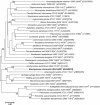High quality draft genome sequence of Brachymonas chironomi AIMA4(T) (DSM 19884(T)) isolated from a Chironomus sp. egg mass
- PMID: 26203340
- PMCID: PMC4511610
- DOI: 10.1186/s40793-015-0010-4
High quality draft genome sequence of Brachymonas chironomi AIMA4(T) (DSM 19884(T)) isolated from a Chironomus sp. egg mass
Abstract
Brachymonas chironomi strain AIMA4(T) (Halpern et al., 2009) is a Gram-negative, non-motile, aerobic, chemoorganotroph bacterium. B. chironomi is a member of the Comamonadaceae, a family within the class Betaproteobacteria. This species was isolated from a chironomid (Diptera; Chironomidae) egg mass, sampled from a waste stabilization pond in northern Israel. Phylogenetic analysis based on the 16S rRNA gene sequences placed strain AIMA4(T) in the genus Brachymonas. Here we describe the features of this organism, together with the complete genome sequence and annotation. The DNA GC content is 63.5%. The chromosome length is 2,509,395 bp. It encodes 2,382 proteins and 68 RNA genes. Brachymonas chironomi genome is part of the Genomic Encyclopedia of Type Strains, Phase I: the one thousand microbial genomes (KMG) project.
Keywords: Brachymonas chironomi; Chironomid; Chironomus; Comamonadaceae; Egg mass; Toxicant.
Figures


References
-
- Hiraishi A, Shin YK, Sugiyama J. Brachymonas denitrificans gen. nov., sp. nov., an aerobic chemoorganotrophic bacterium which contains rhodoquinones, and evolutionary relationships of rhodoquinone producers to bacterial species with various quinone classes. J Gen Appl Microbiol. 1995;41:99–117. doi: 10.2323/jgam.41.99. - DOI
LinkOut - more resources
Full Text Sources
Other Literature Sources
Molecular Biology Databases
Miscellaneous

